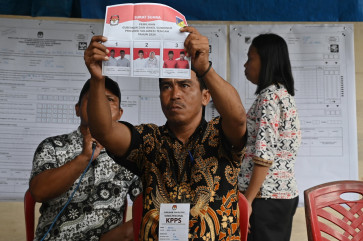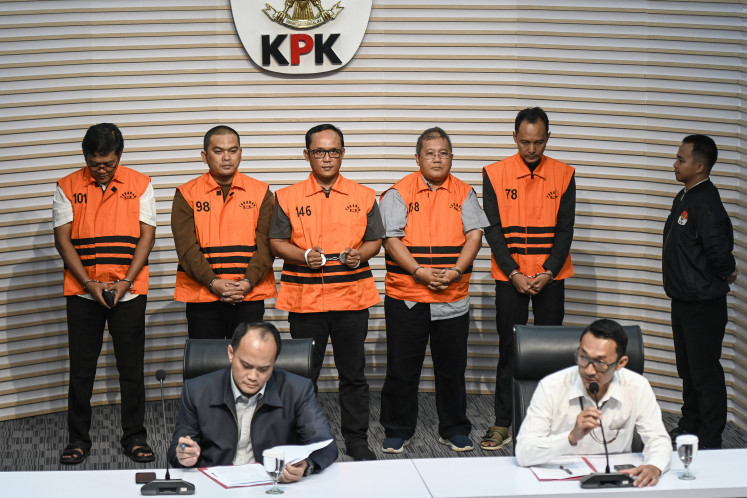Popular Reads
Top Results
Can't find what you're looking for?
View all search resultsPopular Reads
Top Results
Can't find what you're looking for?
View all search resultsShould ASEAN bid for the World Cup?
Change text size
Gift Premium Articles
to Anyone
A
mid heavy political discussions, there was at least one moment of levity during the recent ASEAN Summit. The president of the International Federation of Association Football (FIFA), Gianni Infantino, presented soccer jerseys to the 10 ASEAN heads of state.
This ceremony marked the beginning of formal cooperation between ASEAN and FIFA to galvanize soccer and social development in the region and hopefully will give a boost to ASEAN’s joint bid to host the 2034 FIFA World Cup.
Based on the ASEAN ministerial meeting on sports last month, Indonesia, Malaysia, Singapore, Thailand and Vietnam will be the leading bidders. If FIFA allows it, it will be the first time five countries have bid to cohost the most celebrated sporting event in the world.
Hosting world-class sporting events is not foreign to ASEAN member states. The Philippines, Thailand and Indonesia have hosted the Asian Games, the largest Asian-wide sporting event held every four years. After succeeding in the 2018 Asian Games, Indonesia will host the U-20 World Cup in 2021. Next year, Vietnam will join Malaysia and Singapore as the only ASEAN countries who have ever hosted Formula 1, the highest-class auto racing competition in the world.
Given the experience of ASEAN member countries in hosting world-class sporting events, the ambition to cohost the world's largest sporting event, with 3.5 billion enthusiastic viewers, should not be taken lightly. The costs and benefits must be carefully measured.
There is, indeed, something alluring about hosting a mega-sporting event. It is a symbol of national pride, prestige and economic progress. Although it allows the host country to showcase its identity and achievement, many scholars, policymakers and activists believe that the cost of organizing such an event outweighs the economic benefit in the long term.
Andrew Zimbalist, an economist from Smith College, points out that while hosting a world cup is intended to attracted investment and boost economic growth, in reality, hosting a megasporting event does not benefit the host country.
Brazil spent approximately US$15 billion to build stadiums, sporting facilities and transportation networks for the 2014 World Cup. Today, the most expensive stadium, Mane Garrincha, which cost $550 million, is used as a parking lot.
Zimbalist also notes that Russia spent $14 billion to build new stadiums and refurbish sports facilities to host the 2018 World Cup. Now taxpayers have to cover the maintenance costs of the new stadiums.
Activists in South Africa argue that hosting the 2010 World Cup had socioeconomic consequences. As a part of city revitalization projects, many poor communities were displaced from their settlements. Not only did the displacement deepen social problems, it also burdened the municipal budget with provisions for temporary settlements on the outskirts of urban areas.
Unlike the economic impact, the social impact of hosting a mega-sporting event is somewhat intangible. There are opportunities to nurture dialogue between communities, cultural exchange, and youth activism through sporting events.
Despite being heavily criticized for a $40 billion investment, the 2008 Olympics in Beijing elevated Beijing's world identity. The number of international tourists rose significantly after the Olympics and tourism businesses improved their services. The local communities were willing to contribute to enhance the safety of neighborhoods and improve the city's sanitation and cleanliness.
With more than half of the region’s population aged under 30 years old, ASEAN has a large pool of young people who are willing and ready to reap the benefits brought about by a healthy sporting culture.
Although it has not yet been meticulously studied, many sporting events have influenced young people to be actively involved in sporting competitions and other sociocultural events in their communities. Scientific research proves that young people who participate in sports have higher self-esteem, value their communities more and build better relationships with their peers. Widespread participation in sporting activities will lessen youth violence such as bullying and vandalism.
ASEAN is home to 634 million people and is, collectively, the fifth largest economy in the world. The region is well known as a world-class tourist destination with diverse culture, warm weather and hospitality. Sponsors, visitors and investors will unquestionably be interested in the region hosting a major sporting event.
Interest in soccer in Southeast Asia is continuously growing. According to FIFA, Indonesia, Vietnam, and Thailand formed three of the six territories that made up 50 percent of Asia’s 1.6 billion viewers during the 2018 World Cup. During the 35th ASEAN Summit, Infantino said, "People in your country, businesses in your country, invest 10 times more in European football than football in ASEAN. We need of course to invest in ASEAN."
The five member states who lead the bidding already enjoy some world-class sports facilities such as Bukit Jalil National Stadium, Malaysia (capacity: 87,411), Shah Alam Stadium, Malaysia (capacity: 80.372), Gelora Bung Karno Stadium, Indonesia (capacity: 77,193), Gelora Bandung Lautan Api Stadium, Indonesia (capacity: 72,000), Rajamangala Stadium, Thailand (capacity: 64,000), National Stadium Singapore (capacity: 55,000), and My Dinh National Stadium, Vietnam (capacity: 50,000).
The most challenging part now is determining how to connect, mobilize, and ensure parity in logistical support to the five countries. However, through more robust infrastructure planning, strong commitment and leadership, and a comprehensive business plan, ASEAN could possibly see the World Cup held in the region in 2034.
ASEAN’s joint bid to host the World Cup will invigorate a critical momentum for ASEAN member states to shape a stronger identity. It also provides the regional bloc with an important opportunity to solidify its commitment to fostering an inclusive, people-oriented, and people-centered community. The economic feasibility to host yet must be further analyzed.
***
Melinda Martinus is lead researcher in socio-cultural affairs and Anuthida Saelaow Qian is research officer at the ASEAN Studies Centre, ISEAS – Yusof Ishak Institute, Singapore.











